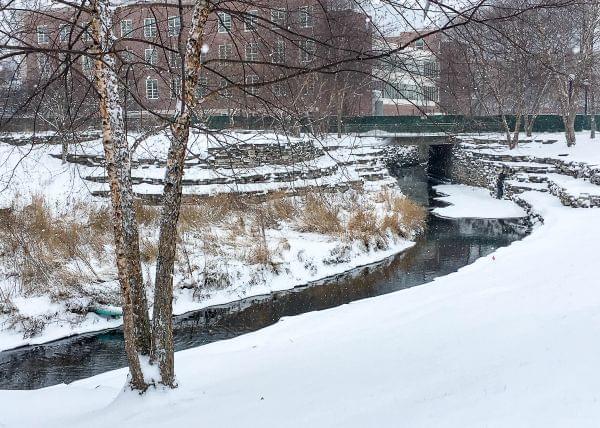All Welcome at Presentations on Waterway Health in Vermilion River Sysem

The Boneyard Creek on campus in winter. Rob Kanter
If you know anything from Environmental Almanac, you know there’s a special place in my heart for rivers and streams. In fact, my very first commentary, which ran in August of 2004, called attention to the benefits achieved for the Boneyard Creek when it was reconfigured on campus by the University of Illinois. That enables me to fish over the lunch hour.
In addition to celebrating campus improvements to the Boneyard, I’ve also called attention to how the cities of Urbana and Champaign have incorporated environmental values in new stormwater infrastructure. I’m especially grateful for the Second Street Basin, where thanks to that infrastructure, I’ve had opportunities to photograph a variety of turtles, birds and other wildlife.
Of course, my attention has extended beyond the urban setting as well.
In 2012, I wrote about a tour of the wastewater treatment plant that discharges into the Saline Branch in northeast Urbana. In that story, as evidence of how well the plant does its job, I pointed out the recent discovery of a big-eyed chub downstream. That’s not likely a fish you know, but it was significant in that no big-eyed chub had been found in Champaign County since 1899.
Also on the plus side for biodiversity, I’ve written about the reintroduction of federally endangered mussels to the Salt Fork and Middle Fork of the Vermilion River by the Illinois Natural History Survey.
None of this is to say we’ve got it all figured out when it comes to waterways in central Illinois.
Just this past summer, the Upper Salt Fork Drainage District spent nearly seven thousand dollars to cut down all of the trees on a mile-long, 20- to 30-foot wide stretch of riverbank, without notifying neighboring homeowners and based on the barest rationale. The potential for degradation of the Salt Fork remains downstream, where a decade-long effort by Sunrise Coal to open a new underground mine continues to keep many who farm and own land in southwestern Vermilion County from resting easy.
And, of course, those who value the Middle Fork of the Vermilion River for the many benefits if provides to both people and wildlife continue the fight to prevent Dynegy from further damaging this jewel by destroying the natural character of the riverbank, and leaving a toxic legacy of coal ash in the floodplain.
For me, it’s interesting to step back now and again and consider how these individual components of local waterway health fit together, and I have the good fortune to do work that enables me to bring others along. This semester in conjunction with an undergraduate class I teach, I’m hosting a series of guest presentations at the University of Illinois on some of these and other questions associated with the Vermilion River system, titled “All Connected.”
The presentations will be free and open to the public. As an added bonus, they’ll afford an opportunity for you to mix with some bright, energetic college students. (For them, attendance is mandatory.) The series will take place on Thursday afternoons from 3:30 to 5:00 p.m. in Room 1306 of Everitt Laboratory on Green Street. We’ll start next week with a talk on environmental ethics and philosophy by Swanlund Chair and Professor of Law Emeritus Eric Freyfogle.
Information about the rest of the series, which will include talks by scientists, farmers, and religious activists, among others, is available through this link:

